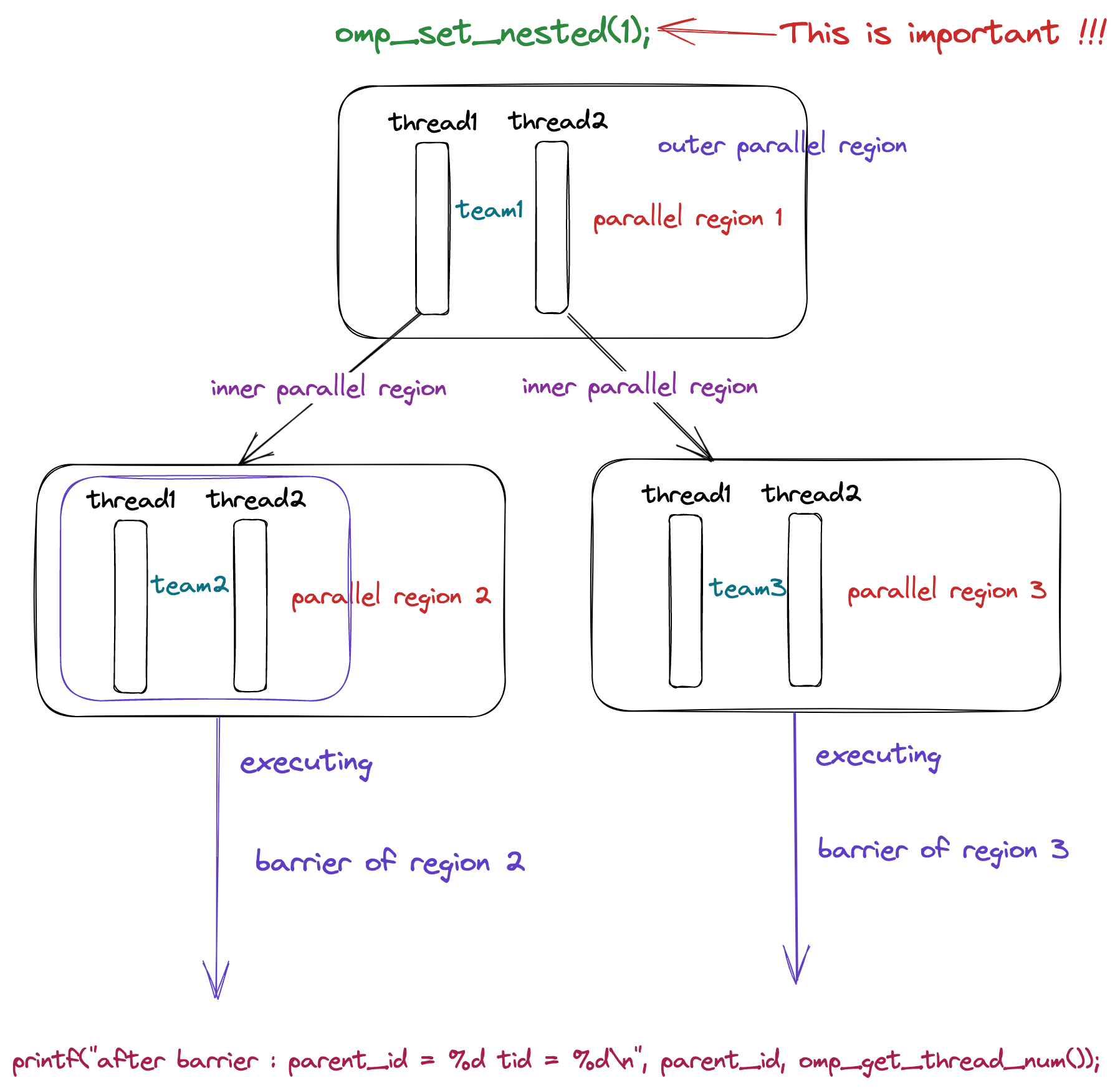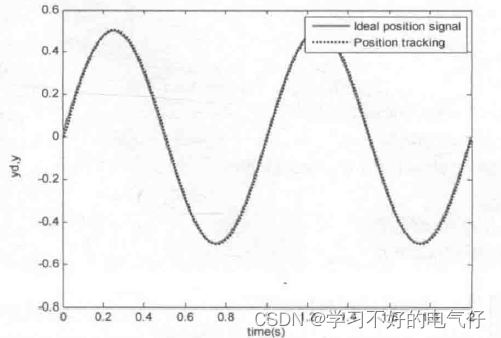1.类加载器
1.1类加载器【理解】
-
作用
负责将.class文件(存储的物理文件)加载在到内存中
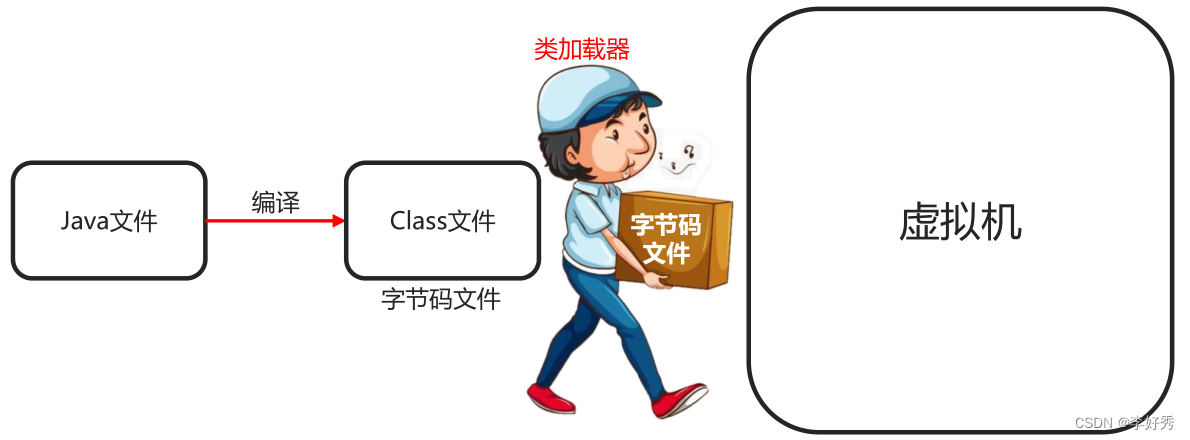
1.2类加载的过程【理解】
-
类加载时机
- 创建类的实例(对象)
- 调用类的类方法
- 访问类或者接口的类变量,或者为该类变量赋值
- 使用反射方式来强制创建某个类或接口对应的java.lang.Class对象
- 初始化某个类的子类
- 直接使用java.exe命令来运行某个主类
-
类加载过程
-
加载
- 通过包名 + 类名,获取这个类,准备用流进行传输
- 在这个类加载到内存中
- 加载完毕创建一个class对象

-
链接
-
验证
确保Class文件字节流中包含的信息符合当前虚拟机的要求,并且不会危害虚拟机自身安全
(文件中的信息是否符合虚拟机规范有没有安全隐患)

-
准备
负责为类的类变量(被static修饰的变量)分配内存,并设置默认初始化值
(初始化静态变量)
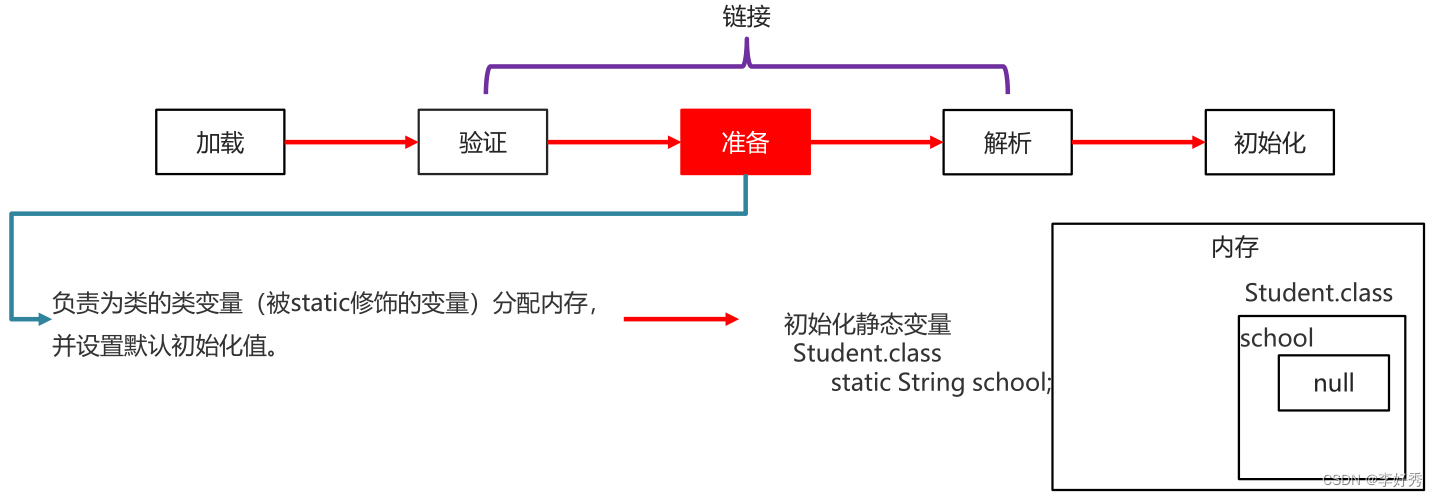
-
解析
将类的二进制数据流中的符号引用替换为直接引用
(本类中如果用到了其他类,此时就需要找到对应的类)

-
-
初始化
根据程序员通过程序制定的主观计划去初始化类变量和其他资源
(静态变量赋值以及初始化其他资源)

-
-
小结
- 当一个类被使用的时候,才会加载到内存
- 类加载的过程: 加载、验证、准备、解析、初始化
1.3类加载的分类【理解】
-
分类
- Bootstrap class loader:虚拟机的内置类加载器,通常表示为null ,并且没有父null
- Platform class loader:平台类加载器,负责加载JDK中一些特殊的模块
- System class loader:系统类加载器,负责加载用户类路径上所指定的类库
-
类加载器的继承关系
- System的父加载器为Platform
- Platform的父加载器为Bootstrap
-
代码演示
public class ClassLoaderDemo1 { public static void main(String[] args) { //获取系统类加载器 ClassLoader systemClassLoader = ClassLoader.getSystemClassLoader(); //获取系统类加载器的父加载器 --- 平台类加载器 ClassLoader classLoader1 = systemClassLoader.getParent(); //获取平台类加载器的父加载器 --- 启动类加载器 ClassLoader classLoader2 = classLoader1.getParent(); System.out.println("系统类加载器" + systemClassLoader); System.out.println("平台类加载器" + classLoader1); System.out.println("启动类加载器" + classLoader2); } }
1.4双亲委派模型【理解】
-
介绍
如果一个类加载器收到了类加载请求,它并不会自己先去加载,而是把这个请求委托给父类的加载器去执行,如果父类加载器还存在其父类加载器,则进一步向上委托,依次递归,请求最终将到达顶层的启动类加载器,如果父类加载器可以完成类加载任务,就成功返回,倘若父类加载器无法完成此加载任务,子加载器才会尝试自己去加载,这就是双亲委派模式
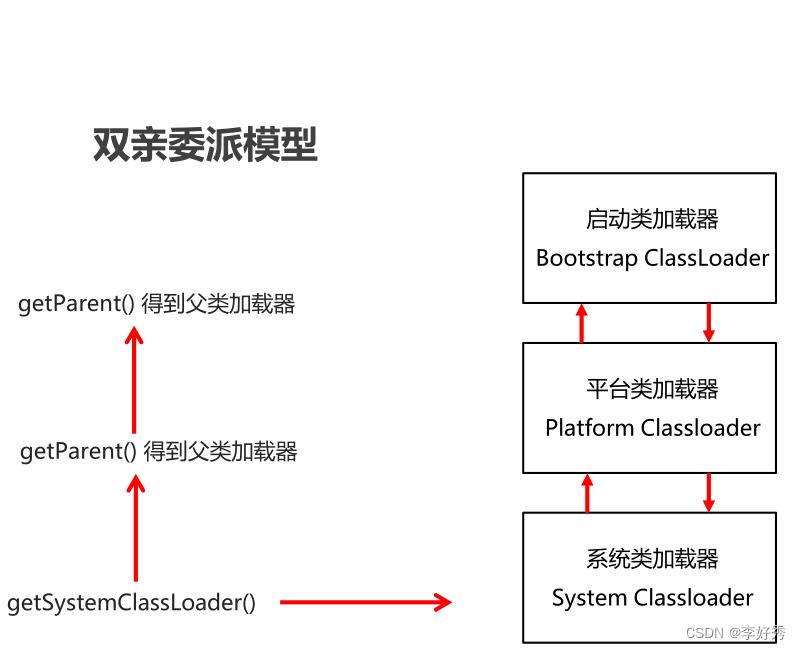
1.5ClassLoader 中的两个方法【应用】
-
方法介绍
方法名 说明 public static ClassLoader getSystemClassLoader() 获取系统类加载器 public InputStream getResourceAsStream(String name) 加载某一个资源文件 -
示例代码
public class ClassLoaderDemo2 { public static void main(String[] args) throws IOException { //static ClassLoader getSystemClassLoader() 获取系统类加载器 //InputStream getResourceAsStream(String name) 加载某一个资源文件 //获取系统类加载器 ClassLoader systemClassLoader = ClassLoader.getSystemClassLoader(); //利用加载器去加载一个指定的文件 //参数:文件的路径(放在src的根目录下,默认去那里加载) //返回值:字节流。 InputStream is = systemClassLoader.getResourceAsStream("prop.properties"); Properties prop = new Properties(); prop.load(is); System.out.println(prop); is.close(); } }
2.反射
2.1反射的概述【理解】
-
反射机制
是在运行状态中,对于任意一个类,都能够知道这个类的所有属性和方法;
对于任意一个对象,都能够调用它的任意属性和方法;
这种动态获取信息以及动态调用对象方法的功能称为Java语言的反射机制。
2.2获取Class类对象的三种方式【应用】
-
三种方式分类
-
类名.class属性
-
对象名.getClass()方法
-
Class.forName(全类名)方法
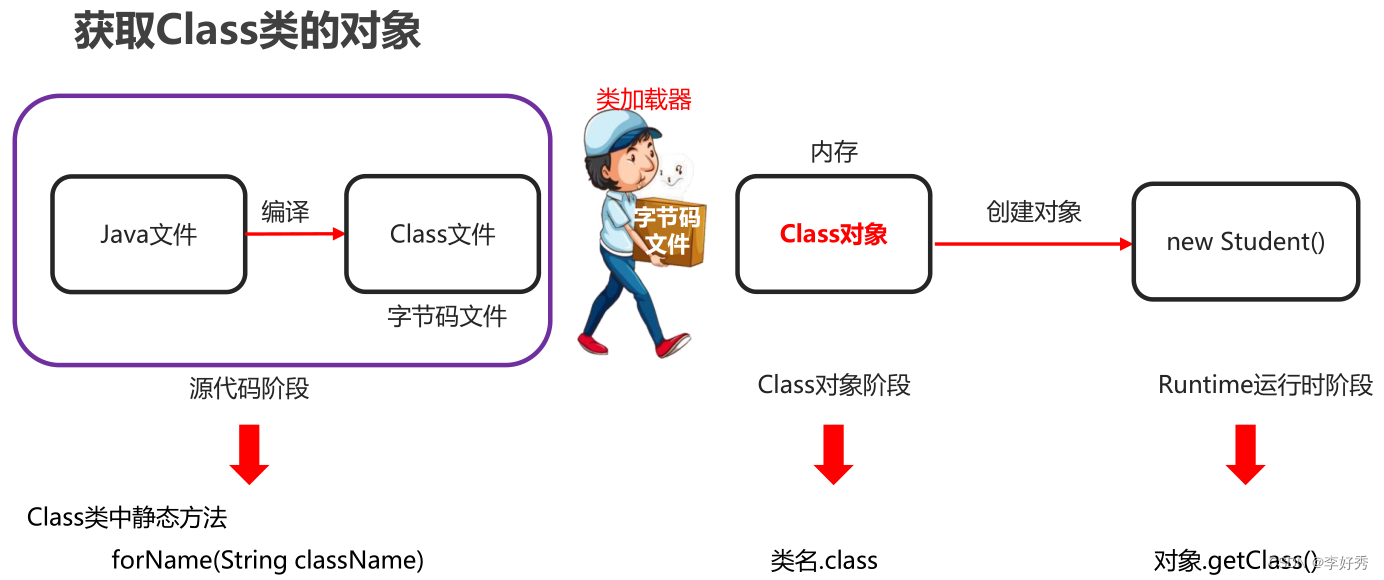
-
-
示例代码
public class Student { private String name; private int age; public Student() { } public Student(String name, int age) { this.name = name; this.age = age; } public String getName() { return name; } public void setName(String name) { this.name = name; } public int getAge() { return age; } public void setAge(int age) { this.age = age; } public void study(){ System.out.println("学生在学习"); } @Override public String toString() { return "Student{" + "name='" + name + '\'' + ", age=" + age + '}'; } } public class ReflectDemo1 { public static void main(String[] args) throws ClassNotFoundException { //1.Class类中的静态方法forName("全类名") //全类名:包名 + 类名 Class clazz = Class.forName("com.itxxx.myreflect2.Student"); System.out.println(clazz); //2.通过class属性来获取 Class clazz2 = Student.class; System.out.println(clazz2); //3.利用对象的getClass方法来获取class对象 //getClass方法是定义在Object类中. Student s = new Student(); Class clazz3 = s.getClass(); System.out.println(clazz3); System.out.println(clazz == clazz2); System.out.println(clazz2 == clazz3); } }
2.3反射获取构造方法并使用【应用】
2.3.1Class类获取构造方法对象的方法
-
方法介绍
方法名 说明 Constructor<?>[] getConstructors() 返回所有公共构造方法对象的数组 Constructor<?>[] getDeclaredConstructors() 返回所有构造方法对象的数组 Constructor getConstructor(Class<?>… parameterTypes) 返回单个公共构造方法对象 Constructor getDeclaredConstructor(Class<?>… parameterTypes) 返回单个构造方法对象 -
示例代码
public class Student { private String name; private int age; //私有的有参构造方法 private Student(String name) { System.out.println("name的值为:" + name); System.out.println("private...Student...有参构造方法"); } //公共的无参构造方法 public Student() { System.out.println("public...Student...无参构造方法"); } //公共的有参构造方法 public Student(String name, int age) { System.out.println("name的值为:" + name + "age的值为:" + age); System.out.println("public...Student...有参构造方法"); } } public class ReflectDemo1 { public static void main(String[] args) throws ClassNotFoundException, NoSuchMethodException { //method1(); //method2(); //method3(); //method4(); } private static void method4() throws ClassNotFoundException, NoSuchMethodException { // Constructor<T> getDeclaredConstructor(Class<?>... parameterTypes): // 返回单个构造方法对象 //1.获取Class对象 Class clazz = Class.forName("com.itxxx.myreflect3.Student"); Constructor constructor = clazz.getDeclaredConstructor(String.class); System.out.println(constructor); } private static void method3() throws ClassNotFoundException, NoSuchMethodException { // Constructor<T> getConstructor(Class<?>... parameterTypes): // 返回单个公共构造方法对象 //1.获取Class对象 Class clazz = Class.forName("com.itxxx.myreflect3.Student"); //小括号中,一定要跟构造方法的形参保持一致. Constructor constructor1 = clazz.getConstructor(); System.out.println(constructor1); Constructor constructor2 = clazz.getConstructor(String.class, int.class); System.out.println(constructor2); //因为Student类中,没有只有一个int的构造,所以这里会报错. Constructor constructor3 = clazz.getConstructor(int.class); System.out.println(constructor3); } private static void method2() throws ClassNotFoundException { // Constructor<?>[] getDeclaredConstructors(): // 返回所有构造方法对象的数组 //1.获取Class对象 Class clazz = Class.forName("com.itxxx.myreflect3.Student"); Constructor[] constructors = clazz.getDeclaredConstructors(); for (Constructor constructor : constructors) { System.out.println(constructor); } } private static void method1() throws ClassNotFoundException { // Constructor<?>[] getConstructors(): // 返回所有公共构造方法对象的数组 //1.获取Class对象 Class clazz = Class.forName("com.itxxx.myreflect3.Student"); Constructor[] constructors = clazz.getConstructors(); for (Constructor constructor : constructors) { System.out.println(constructor); } } }
2.3.2Constructor类用于创建对象的方法
-
方法介绍
方法名 说明 T newInstance(Object…initargs) 根据指定的构造方法创建对象 setAccessible(boolean flag) 设置为true,表示取消访问检查 -
示例代码
// Student类同上一个示例,这里就不在重复提供了 public class ReflectDemo2 { public static void main(String[] args) throws ClassNotFoundException, NoSuchMethodException, IllegalAccessException, InvocationTargetException, InstantiationException { //T newInstance(Object... initargs):根据指定的构造方法创建对象 //method1(); //method2(); //method3(); //method4(); } private static void method4() throws ClassNotFoundException, NoSuchMethodException, InstantiationException, IllegalAccessException, InvocationTargetException { //获取一个私有的构造方法并创建对象 //1.获取class对象 Class clazz = Class.forName("com.itxxx.myreflect3.Student"); //2.获取一个私有化的构造方法. Constructor constructor = clazz.getDeclaredConstructor(String.class); //被private修饰的成员,不能直接使用的 //如果用反射强行获取并使用,需要临时取消访问检查 constructor.setAccessible(true); //3.直接创建对象 Student student = (Student) constructor.newInstance("zhangsan"); System.out.println(student); } private static void method3() throws ClassNotFoundException, InstantiationException, IllegalAccessException { //简写格式 //1.获取class对象 Class clazz = Class.forName("com.itxxx.myreflect3.Student"); //2.在Class类中,有一个newInstance方法,可以利用空参直接创建一个对象 Student student = (Student) clazz.newInstance();//这个方法现在已经过时了,了解一下 System.out.println(student); } private static void method2() throws ClassNotFoundException, NoSuchMethodException, InstantiationException, IllegalAccessException, InvocationTargetException { //1.获取class对象 Class clazz = Class.forName("com.itxxx.myreflect3.Student"); //2.获取构造方法对象 Constructor constructor = clazz.getConstructor(); //3.利用空参来创建Student的对象 Student student = (Student) constructor.newInstance(); System.out.println(student); } private static void method1() throws ClassNotFoundException, NoSuchMethodException, InstantiationException, IllegalAccessException, InvocationTargetException { //1.获取class对象 Class clazz = Class.forName("com.itxxx.myreflect3.Student"); //2.获取构造方法对象 Constructor constructor = clazz.getConstructor(String.class, int.class); //3.利用newInstance创建Student的对象 Student student = (Student) constructor.newInstance("zhangsan", 23); System.out.println(student); } }
2.3.3小结
-
获取class对象
三种方式: Class.forName(“全类名”), 类名.class, 对象名.getClass()
-
获取里面的构造方法对象
getConstructor (Class<?>... parameterTypes) getDeclaredConstructor (Class<?>… parameterTypes)
-
如果是public的,直接创建对象
newInstance(Object… initargs)
-
如果是非public的,需要临时取消检查,然后再创建对象
setAccessible(boolean) 暴力反射
2.4反射获取成员变量并使用【应用】
2.4.1Class类获取成员变量对象的方法
-
方法分类
方法名 说明 Field[] getFields() 返回所有公共成员变量对象的数组 Field[] getDeclaredFields() 返回所有成员变量对象的数组 Field getField(String name) 返回单个公共成员变量对象 Field getDeclaredField(String name) 返回单个成员变量对象 -
示例代码
public class Student { public String name; public int age; public String gender; private int money = 300; @Override public String toString() { return "Student{" + "name='" + name + '\'' + ", age=" + age + ", gender='" + gender + '\'' + ", money=" + money + '}'; } } public class ReflectDemo1 { public static void main(String[] args) throws ClassNotFoundException, NoSuchFieldException { // method1(); //method2(); //method3(); //method4(); } private static void method4() throws ClassNotFoundException, NoSuchFieldException { // Field getDeclaredField(String name):返回单个成员变量对象 //1.获取class对象 Class clazz = Class.forName("com.itxxx.myreflect4.Student"); //2.获取money成员变量 Field field = clazz.getDeclaredField("money"); //3.打印一下 System.out.println(field); } private static void method3() throws ClassNotFoundException, NoSuchFieldException { // Field getField(String name):返回单个公共成员变量对象 //想要获取的成员变量必须是真实存在的 //且必须是public修饰的. //1.获取class对象 Class clazz = Class.forName("com.itxxx.myreflect4.Student"); //2.获取name这个成员变量 //Field field = clazz.getField("name"); //Field field = clazz.getField("name1"); Field field = clazz.getField("money"); //3.打印一下 System.out.println(field); } private static void method2() throws ClassNotFoundException { // Field[] getDeclaredFields():返回所有成员变量对象的数组 //1.获取class对象 Class clazz = Class.forName("com.itxxx.myreflect4.Student"); //2.获取所有的Field对象 Field[] fields = clazz.getDeclaredFields(); //3.遍历 for (Field field : fields) { System.out.println(field); } } private static void method1() throws ClassNotFoundException { // Field[] getFields():返回所有公共成员变量对象的数组 //1.获取class对象 Class clazz = Class.forName("com.itxxx.myreflect4.Student"); //2.获取Field对象. Field[] fields = clazz.getFields(); //3.遍历 for (Field field : fields) { System.out.println(field); } } }
2.4.2Field类用于给成员变量赋值的方法
-
方法介绍
方法名 说明 void set(Object obj, Object value) 赋值 Object get(Object obj) 获取值 -
示例代码
// Student类同上一个示例,这里就不在重复提供了 public class ReflectDemo2 { public static void main(String[] args) throws ClassNotFoundException, NoSuchFieldException, IllegalAccessException, InstantiationException { // Object get(Object obj) 返回由该 Field表示的字段在指定对象上的值。 //method1(); //method2(); } private static void method2() throws ClassNotFoundException, NoSuchFieldException, InstantiationException, IllegalAccessException { //1.获取class对象 Class clazz = Class.forName("com.itxxx.myreflect4.Student"); //2.获取成员变量Field的对象 Field field = clazz.getDeclaredField("money"); //3.取消一下访问检查 field.setAccessible(true); //4.调用get方法来获取值 //4.1创建一个对象 Student student = (Student) clazz.newInstance(); //4.2获取指定对象的money的值 Object o = field.get(student); //5.打印一下 System.out.println(o); } private static void method1() throws ClassNotFoundException, NoSuchFieldException, InstantiationException, IllegalAccessException { // void set(Object obj, Object value):给obj对象的成员变量赋值为value //1.获取class对象 Class clazz = Class.forName("com.itxxx.myreflect4.Student"); //2.获取name这个Field对象 Field field = clazz.getField("name"); //3.利用set方法进行赋值. //3.1先创建一个Student对象 Student student = (Student) clazz.newInstance(); //3.2有了对象才可以给指定对象进行赋值 field.set(student,"zhangsan"); System.out.println(student); } }
2.5反射获取成员方法并使用【应用】
2.5.1Class类获取成员方法对象的方法
-
方法分类
方法名 说明 Method[] getMethods() 返回所有公共成员方法对象的数组,包括继承的 Method[] getDeclaredMethods() 返回所有成员方法对象的数组,不包括继承的 Method getMethod(String name, Class<?>… parameterTypes) 返回单个公共成员方法对象 Method getDeclaredMethod(String name, Class<?>… parameterTypes) 返回单个成员方法对象 -
注意
getDeclaredMethod() 获取的是类自身声明的所有方法,包含public、protected和private方法。
getMethod () 获取的是类的所有共有方法,这就包括自身的所有public方法,和从基类继承的、从接口实现的所有public方法。
-
示例代码
public class Student { //私有的,无参无返回值 private void show() { System.out.println("私有的show方法,无参无返回值"); } //公共的,无参无返回值 public void function1() { System.out.println("function1方法,无参无返回值"); } //公共的,有参无返回值 public void function2(String name) { System.out.println("function2方法,有参无返回值,参数为" + name); } //公共的,无参有返回值 public String function3() { System.out.println("function3方法,无参有返回值"); return "aaa"; } //公共的,有参有返回值 public String function4(String name) { System.out.println("function4方法,有参有返回值,参数为" + name); return "aaa"; } } public class ReflectDemo1 { public static void main(String[] args) throws ClassNotFoundException, NoSuchMethodException { //method1(); //method2(); //method3(); //method4(); //method5(); } private static void method5() throws ClassNotFoundException, NoSuchMethodException { // Method getDeclaredMethod(String name, Class<?>... parameterTypes): // 返回单个成员方法对象 //1.获取class对象 Class clazz = Class.forName("com.itxxx.myreflect5.Student"); //2.获取一个成员方法show Method method = clazz.getDeclaredMethod("show"); //3.打印一下 System.out.println(method); } private static void method4() throws ClassNotFoundException, NoSuchMethodException { //1.获取class对象 Class clazz = Class.forName("com.itxxx.myreflect5.Student"); //2.获取一个有形参的方法function2 Method method = clazz.getMethod("function2", String.class); //3.打印一下 System.out.println(method); } private static void method3() throws ClassNotFoundException, NoSuchMethodException { // Method getMethod(String name, Class<?>... parameterTypes) : // 返回单个公共成员方法对象 //1.获取class对象 Class clazz = Class.forName("com.itxxx.myreflect5.Student"); //2.获取成员方法function1 Method method1 = clazz.getMethod("function1"); //3.打印一下 System.out.println(method1); } private static void method2() throws ClassNotFoundException { // Method[] getDeclaredMethods(): // 返回所有成员方法对象的数组,不包括继承的 //1.获取class对象 Class clazz = Class.forName("com.itxxx.myreflect5.Student"); //2.获取Method对象 Method[] methods = clazz.getDeclaredMethods(); //3.遍历一下数组 for (Method method : methods) { System.out.println(method); } } private static void method1() throws ClassNotFoundException { // Method[] getMethods():返回所有公共成员方法对象的数组,包括继承的 //1.获取class对象 Class clazz = Class.forName("com.itxxx.myreflect5.Student"); //2.获取成员方法对象 Method[] methods = clazz.getMethods(); //3.遍历 for (Method method : methods) { System.out.println(method); } } }
2.5.2Method类用于执行方法的方法
-
方法介绍
方法名 说明 Object invoke(Object obj, Object… args) 运行方法 参数一: 用obj对象调用该方法
参数二: 调用方法的传递的参数(如果没有就不写)
返回值: 方法的返回值(如果没有就不写)
-
示例代码
public class ReflectDemo2 { public static void main(String[] args) throws ClassNotFoundException, NoSuchMethodException, IllegalAccessException, InstantiationException, InvocationTargetException { // Object invoke(Object obj, Object... args):运行方法 // 参数一:用obj对象调用该方法 // 参数二:调用方法的传递的参数(如果没有就不写) // 返回值:方法的返回值(如果没有就不写) //1.获取class对象 Class clazz = Class.forName("com.itxxx.myreflect5.Student"); //2.获取里面的Method对象 function4 Method method = clazz.getMethod("function4", String.class); //3.运行function4方法就可以了 //3.1创建一个Student对象,当做方法的调用者 Student student = (Student) clazz.newInstance(); //3.2运行方法 Object result = method.invoke(student, "zhangsan"); //4.打印一下返回值 System.out.println(result); } }
3.http服务器改写
3.1静态资源和动态资源【理解】
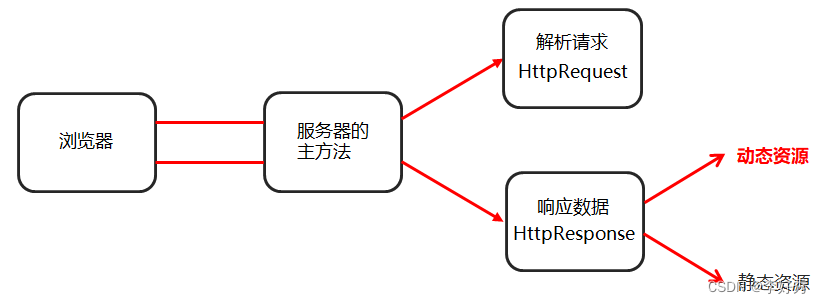
-
静态资源
在服务器提前准备好的文件。(图片,文本)

-
动态资源
在图示的案例中,当用户点击了浏览器上的按钮。
本质上访问的就是服务端的某一个类中的某一个方法。
在方法中,可以写一些判断代码和逻辑代码,让响应的内容,有可能不一样了。
那么,服务端所对应的这个类我们常常将其称之为“动态资源”

3.2准备工作【理解】
-
修改四个地方
- HttpResponse -> 常量WEB_APP_PATH的值与当前模块一致
- HttpServer -> main方法中端口改成80
- HttpResponse -> 添加一个write方法,添加一个带参数的构造方法
- HttpResponse -> 添加一个contentType成员变量,生成对应的set/get方法
-
示例代码
// 1.HttpResponse -> 常量WEB_APP_PATH的值与当前模块一致 public class HttpResponse { ... public static final String WEB_APP_PATH = "http-dynamic-server\\webapp"; ... } // 2.HttpServer -> main方法中端口改成80 public class HttpServer { public static void main(String[] args) throws IOException { ... //2.让这个通道绑定一个端口 serverSocketChannel.bind(new InetSocketAddress(80)); ... } } // 3.HttpResponse -> 添加一个write方法,添加一个带参数的构造方法 public class HttpResponse { ... // 已经提供了selectionKey,所以之前的方法接收这个参数的可以去掉了,直接使用这个即可 // HttpRequest也按照此方式进行优化,定义成员变量,在构造方法中赋值,其他方法直接使用即可 private SelectionKey selectionKey; public HttpResponse(SelectionKey selectionKey) { this.selectionKey = selectionKey; } //给浏览器响应数据的方法 ---- 浏览器在请求动态资源时,响应数据的方法. //content:响应的内容 public void write(String content){ } ... } public class HttpServer { public static void main(String[] args) throws IOException { ... //响应数据 //修改后的构造方法中要传入参数 HttpResponse httpResponse = new HttpResponse(selectionKey); ... } } // 4.HttpResponse -> 添加一个contentType成员变量,生成对应的set/get方法 public class HttpResponse { ... private String contentType;//MIME类型 public String getContentType() { return contentType; } public void setContentTpye(String contentType) { this.contentType = contentType; //添加到map集合中 hm.put("Content-Type",contentType); } ... }
3.3浏览器请求动态资源【理解】
-
两个小问题
-
服务器如何判断浏览器请求的是静态资源还是动态资源?
我们可以规定:如果浏览器地址栏中的uri是以”/servlet”开始的,那么就表示请求动态资源
-
在一个项目中有很多类,很多方法。那么请求过来之后,执行哪个方法呢?
写一个UserServlet类,在类中写service方法
我们可以规定:如果请求动态资源,就创建这个类对象,并调用service方法,表示服务器处理了当前请求
-
-
实现步骤
-
解析http请求
-
处理浏览器请求
定义一个UserServlet 类,类中定义service方法,处理浏览器请求动态资源
解析完http请求之后,再判断uri是否以/servlet开头 -
响应
-
-
示例代码
public class UserServlet{ public void service(){ //模拟业务处理 ---- 就可以对这个手机号进行判断验证 System.out.println("UserServlet处理了用户的请求..."); } } public class HttpServer { public static void main(String[] args) throws IOException { ... //响应数据 HttpResponse httpResponse = new HttpResponse(selectionKey); httpResponse.setHttpRequest(httpRequest); if(httpRequest.getRequestURI().startsWith("/servlet")){ //本次请求动态资源 //处理 UserServlet userServlet = new UserServlet(); userServlet.service(); //响应 httpResponse.setContentTpye("text/html;charset=UTF-8"); httpResponse.write("ok,UserServlet处理了本次请求...."); }else{ //本次请求静态资源 httpResponse.sendStaticResource(); } ... } } public class HttpResponse { ... //给浏览器响应数据的方法 ---- 浏览器在请求动态资源时,响应数据的方法. //content:响应的内容 public void write(String content){ //准备响应行数据 this.version = "HTTP/1.1"; this.status = "200"; this.desc = "ok"; //把响应行拼接在一起 String responseLine = this.version + " " + this.status + " " + this.desc + "\r\n"; //准备响应头 StringBuilder sb = new StringBuilder(); Set<Map.Entry<String, String>> entries = hm.entrySet(); for (Map.Entry<String, String> entry : entries) { //entry依次表示每一个键值对对象 //键 --- 响应头的名称 //值 --- 响应头的值 sb.append(entry.getKey()).append(": ").append(entry.getValue()).append("\r\n"); } //处理响应空行 String emptyLine = "\r\n"; //拼接响应行,响应头,响应空行 String result = responseLine + sb.toString() + emptyLine; try { //给浏览器响应 响应行,响应头,响应空行 ByteBuffer byteBuffer1 = ByteBuffer.wrap(result.getBytes()); SocketChannel channel = (SocketChannel) selectionKey.channel(); channel.write(byteBuffer1); //给浏览器响应 响应体 ByteBuffer byteBuffer2 = ByteBuffer.wrap(content.getBytes()); channel.write(byteBuffer2); //释放资源 channel.close(); } catch (IOException e) { System.out.println("响应数据失败...."); e.printStackTrace(); } } ... }
3.4main方法和Servlet优化【理解】
-
main方法优化
-
需求
将请求动态资源的代码抽取到一个单独的类单独的方法中,简化main中的代码
-
代码实现
public class DynamicResourceProcess { //执行指定动态资源的service方法 //参数一 //由于后期可能根据用户请求的uri做出相应的处理. //参数二 //要给用户响应数据,那么就需要使用到httpResponse. public void process(HttpRequest httpRequest,HttpResponse httpResponse) { // 创建UserServlet对象,调用service方法,进行处理 UserServlet userServlet = new UserServlet(); userServlet.service(); //给浏览器响应 httpResponse.setContentTpye("text/html;charset=UTF-8"); httpResponse.write("ok,UserServlet处理了本次请求...."); } } public class HttpServer { public static void main(String[] args) throws IOException { ... //响应数据 HttpResponse httpResponse = new HttpResponse(selectionKey); httpResponse.setHttpRequest(httpRequest); if(httpRequest.getRequestURI().startsWith("/servlet")){ //本次请求动态资源 DynamicResourceProcess drp = new DynamicResourceProcess(); drp.process(httpRequest,httpResponse); }else{ //本次请求静态资源 httpResponse.sendStaticResource(); } ... } }
-
-
Servlet优化
-
需求
将给浏览器响应的代码写到Servlet中
-
代码实现
public class UserServlet implements HttpServlet{ //处理浏览器请求的方法 //参数一 //由于后期可能根据用户请求的uri做出相应的处理. //参数二 //要给用户响应数据,那么就需要使用到httpResponse. public void service(HttpRequest httpRequest, HttpResponse httpResponse){ //模拟业务处理 ---- 就可以对这个手机号进行判断验证 System.out.println("UserServlet处理了用户的请求..."); //给浏览器响应 httpResponse.setContentTpye("text/html;charset=UTF-8"); httpResponse.write("ok,UserServlet处理了本次请求...."); } } public class DynamicResourceProcess { //执行指定动态资源的service方法 //参数一 //由于后期可能根据用户请求的uri做出相应的处理. //参数二 //要给用户响应数据,那么就需要使用到httpResponse. public void process(HttpRequest httpRequest,HttpResponse httpResponse) { // 创建UserServlet对象,调用service方法,进行处理 UserServlet userServlet = new UserServlet(); userServlet.service(httpRequest,httpResponse); } }
-
3.5多个动态资源【理解】
-
多个动态资源
针对每一个业务操作,我们都会去定义一个对应的Servlet来完成。
就会在服务端产生很多个Servlet

-
实现步骤
- 定义一个接口HttpServlet,接口中定义service方法。
- 针对于每一种业务,都定义一个servlet类与之对应,该类实现HttpServlet接口
- 获取请求的uri,进行判断,调用不同的servlet类中的service方法
-
代码实现
// 1.定义一个接口HttpServlet,接口中定义service方法 public interface HttpServlet { //定义业务处理的方法 public abstract void service(HttpRequest httpRequest, HttpResponse httpResponse); } // 2.针对于每一种业务,都定义一个servlet类与之对应,该类实现HttpServlet接口 public class UserServlet implements HttpServlet{ //处理浏览器请求的方法 //参数一 //由于后期可能根据用户请求的uri做出相应的处理. //参数二 //要给用户响应数据,那么就需要使用到httpResponse. public void service(HttpRequest httpRequest, HttpResponse httpResponse){ //模拟业务处理 ---- 就可以对这个手机号进行判断验证 System.out.println("UserServlet处理了用户的请求..."); //给浏览器响应 httpResponse.setContentTpye("text/html;charset=UTF-8"); httpResponse.write("ok,UserServlet处理了本次请求...."); } } public class LoginServlet implements HttpServlet{ @Override public void service(HttpRequest httpRequest, HttpResponse httpResponse) { //处理 System.out.println("LoginServlet处理了登录请求"); //响应 httpResponse.setContentTpye("text/html;charset=UTF-8"); httpResponse.write("登录成功"); } } public class RegisterServlet implements HttpServlet{ @Override public void service(HttpRequest httpRequest, HttpResponse httpResponse) { //处理 System.out.println("RegisterServlet处理了注册请求"); //响应 httpResponse.setContentTpye("text/html;charset=UTF-8"); httpResponse.write("注册成功"); } } public class SearchServlet implements HttpServlet{ @Override public void service(HttpRequest httpRequest, HttpResponse httpResponse) { //处理 System.out.println("SearchServlet处理了搜索商品请求"); //响应 httpResponse.setContentTpye("text/html;charset=UTF-8"); httpResponse.write("响应了一些商品信息"); } } // 3.获取请求的uri,进行判断,调用不同的servlet类中的service方法 public class DynamicResourceProcess { public void process(HttpRequest httpRequest,HttpResponse httpResponse){ //获取请求的uri String requestURI = httpRequest.getRequestURI(); //根据请求的uri进行判断 if("/servlet/loginservlet".equals(requestURI)){ //登录请求 LoginServlet loginServlet = new LoginServlet(); loginServlet.service(httpRequest,httpResponse); }else if("/servlet/registerservlet".equals(requestURI)){ //注册请求 RegisterServlet registerServlet = new RegisterServlet(); registerServlet.service(httpRequest,httpResponse); }else if("/servlet/searchservlet".equals(requestURI)){ //搜索商品请求 SearchServlet searchServlet = new SearchServlet(); searchServlet.service(httpRequest,httpResponse); }else{ //表示默认处理方法 //创建UserServlet对象,调用service方法,进行处理 UserServlet userServlet = new UserServlet(); userServlet.service(httpRequest,httpResponse); } } }
3.6通过反射和配置文件优化【理解】
-
优化步骤
-
把Servlet信息写到properties配置文件中
格式为:servlet-info=/servlet/UserServlet,全类名;/servlet/loginServlet,全类名
-
定义一个接口ServletConcurrentHashMap,接口中定义ConcurrentHashMap,该集合存储所有的servlet信息
-
定义一个接口ParseServletConfig,该接口中定义一个方法(parse)
-
定义ParseServletConfig的实现类,解析配置文件,并把配置文件中Servlet信息存到map集合中
-
在main方法的第一行,开启一条线程执行解析配置文件的代码
-
修改处理DynamicResourceProcess中的process方法
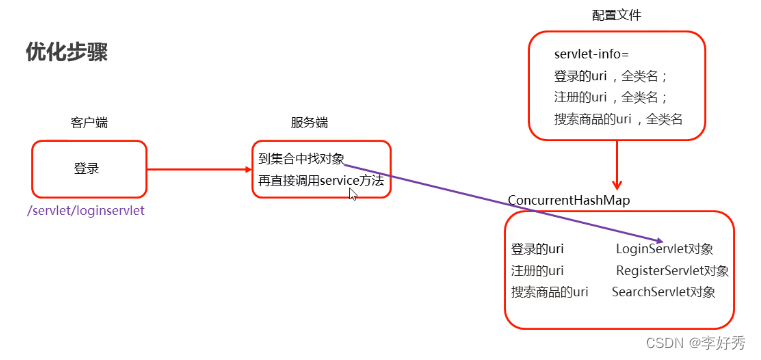
-
-
代码实现
// 1.把Servlet信息写到properties配置文件中 // 在webapp\config\servlet-info.properties文件中,写入如下内容 servlet-info=/servlet/loginservlet,com.itxxx.myservlet.LoginServlet;/servlet/registerservlet,com.itxxx.myservlet.RegisterServlet;/servlet/searchservlet,com.itxxx.myservlet.SearchServlet;/servlet/lostpasswordservlet,com.itxxx.myservlet.LostPasswordServlet // 2.定义一个接口ServletConcurrentHashMap,接口中定义ConcurrentHashMap,该集合存储所有的servlet信息 public interface ServletConcurrentHashMap { //存储请求路径和对应的servlet的map集合 //键: 请求的uri //值: 对应的Servlet对象 public static final ConcurrentHashMap<String, HttpServlet> map = new ConcurrentHashMap<>(); } // 3.定义一个接口ParseServletConfig,该接口中定义一个方法(parse) public interface ParseServletConfig { //解析数据的方法 public abstract void parse(); } // 4.定义ParseServletConfig的实现类,解析配置文件,并把配置文件中Servlet信息存到map集合中 public class PropertiesParseServletConfig implements ParseServletConfig { @Override public void parse() { try { //1.读取配置文件中的数据 Properties properties = new Properties(); FileReader fr = new FileReader("http-dynamic-server/webapp/config/servlet-info.properties"); properties.load(fr); fr.close(); //2.获取集合中servlet-info的属性值 String properValue = (String) properties.get("servlet-info"); // uri,全类名;uri,全类名 //3.解析 String[] split = properValue.split(";"); for (String servletInfo : split) { String[] servletInfoArr = servletInfo.split(","); String uri = servletInfoArr[0]; String servletName = servletInfoArr[1]; //我们需要通过servletName(全类名)来创建他的对象 Class clazz = Class.forName(servletName); HttpServlet httpServlet = (HttpServlet) clazz.newInstance(); //4.将uri和httpServlet添加到map集合中 ServletConcurrentHashMap.map.put(uri,httpServlet); } } catch (Exception e) { System.out.println("解析数据异常....."); e.printStackTrace(); } } } public class LoaderResourceRunnable implements Runnable { @Override public void run() { //执行parse方法 ParseServletConfig parseServletConfig = new PropertiesParseServletConfig(); parseServletConfig.parse(); } } // 5.在main方法的第一行,开启一条线程执行解析配置文件的代码 public class HttpServer { public static void main(String[] args) throws IOException { //开启一条线程去解析配置文件 new Thread(new LoaderResourceRunnable()).start(); ... } } // 6.修改处理DynamicResourceProcess中的process方法 public class DynamicResourceProcess { public void process(HttpRequest httpRequest,HttpResponse httpResponse){ //获取请求的uri String requestURI = httpRequest.getRequestURI(); //根据请求的uri到map集合中直接找到对应的servlet的对象 HttpServlet httpServlet = ServletConcurrentHashMap.map.get(requestURI); //调用service方法对请求进行处理并响应 httpServlet.service(httpRequest,httpResponse); } }
3.7Servlet忘记实现HttpServlet接口处理【理解】
-
出现情况
在写Servlet时,忘记了实现HttpServlet接口
-
导致结果
在反射创建对象后,强转成HttpServlet时,会报类型转换异常
-
解决方案
在反射创建对象后,强转成HttpServlet前,进行判断
如果有实现HttpServlet接口,就进行强转
否则抛出一个异常
-
代码实现
public class PropertiesParseServletConfig implements ParseServletConfig { @Override public void parse() { try { //1.读取配置文件中的数据 Properties properties = new Properties(); FileReader fr = new FileReader("http-dynamic-server/webapp/config/servlet-info.properties"); properties.load(fr); fr.close(); //2.获取集合中servlet-info的属性值 String properValue = (String) properties.get("servlet-info"); // uri,全类名;uri,全类名 //3.解析 String[] split = properValue.split(";"); for (String servletInfo : split) { String[] servletInfoArr = servletInfo.split(","); String uri = servletInfoArr[0]; String servletName = servletInfoArr[1]; //我们需要通过servletName(全类名)来创建他的对象 Class clazz = Class.forName(servletName); //获取该类所实现的所有的接口信息,得到的是一个数组 Class[] interfaces = clazz.getInterfaces(); //定义一个boolean类型的变量 boolean flag = false; //遍历数组 for (Class clazzInfo : interfaces) { //判断当前所遍历的接口的字节码对象是否和HttpServlet的字节码文件对象相同 if(clazzInfo == HttpServlet.class){ //如果相同,就需要更改flag值.结束循环 flag = true; break; } } if(flag){ //true就表示当前的类已经实现了HttpServlet接口 HttpServlet httpServlet = (HttpServlet) clazz.newInstance(); //4.将uri和httpServlet添加到map集合中 ServletConcurrentHashMap.map.put(uri,httpServlet); }else{ //false就表示当前的类还没有实现HttpServlet接口 throw new NotImplementsHttpServletException(clazz.getName() + "Not Implements HttpServlet"); } } } catch (NotImplementsHttpServletException e) { e.printStackTrace(); }catch (Exception e) { System.out.println("解析数据异常....."); e.printStackTrace(); } } }
3.8响应404【理解】
-
出现情况
客户端浏览器请求了一个服务器中不存在的动态资源
-
导致结果
服务器中代码出现异常,程序停止
-
解决方案
如果请求的动态资源不存在,服务器根据请求的uri找到对应的Servlet时为null,继续调用方法会出现异常
增加一个非空的判断,如果不为null,则继续处理请求,调用方法
如果为null,则响应404
-
代码实现
public class DynamicResourceProcess { //执行指定动态资源的service方法 //参数一 //由于后期可能根据用户请求的uri做出相应的处理. //参数二 //要给用户响应数据,那么就需要使用到httpResponse. public void process(HttpRequest httpRequest,HttpResponse httpResponse){ //获取请求的uri String requestURI = httpRequest.getRequestURI(); //根据请求的uri到map集合中直接找到对应的servlet的对象 HttpServlet httpServlet = ServletConcurrentHashMap.map.get(requestURI); if(httpServlet != null){ //调用service方法对请求进行处理并响应 httpServlet.service(httpRequest,httpResponse); }else{ //浏览器请求的动态资源不存在 //响应404 response404(httpResponse); } } //浏览器请求动态资源不存在,响应404的方法 private void response404(HttpResponse httpResponse) { try { //准备响应行 String responseLine = "HTTP/1.1 404 NOT FOUND\r\n"; //准备响应头 String responseHeader = "Content-Type: text/html;charset=UTF-8\r\n"; //准备响应空行 String emptyLine = "\r\n"; //拼接在一起 String result = responseLine + responseHeader + emptyLine; //把响应行,响应头,响应空行去响应给浏览器 SelectionKey selectionKey = httpResponse.getSelectionKey(); SocketChannel channel = (SocketChannel) selectionKey.channel(); ByteBuffer byteBuffer1 = ByteBuffer.wrap(result.getBytes()); channel.write(byteBuffer1); //给浏览器 响应 响应体内容 ByteBuffer byteBuffer2 = ByteBuffer.wrap("404 NOT FOUND....".getBytes()); channel.write(byteBuffer2); //释放资源 channel.close(); } catch (IOException e) { e.printStackTrace(); } } }
et(requestURI);
if(httpServlet != null){
//调用service方法对请求进行处理并响应
httpServlet.service(httpRequest,httpResponse);
}else{
//浏览器请求的动态资源不存在
//响应404
response404(httpResponse);
}
}
//浏览器请求动态资源不存在,响应404的方法
private void response404(HttpResponse httpResponse) {
try {
//准备响应行
String responseLine = “HTTP/1.1 404 NOT FOUND\r\n”;
//准备响应头
String responseHeader = “Content-Type: text/html;charset=UTF-8\r\n”;
//准备响应空行
String emptyLine = “\r\n”;
//拼接在一起
String result = responseLine + responseHeader + emptyLine;
//把响应行,响应头,响应空行去响应给浏览器
SelectionKey selectionKey = httpResponse.getSelectionKey();
SocketChannel channel = (SocketChannel) selectionKey.channel();
ByteBuffer byteBuffer1 = ByteBuffer.wrap(result.getBytes());
channel.write(byteBuffer1);
//给浏览器 响应 响应体内容
ByteBuffer byteBuffer2 = ByteBuffer.wrap("404 NOT FOUND....".getBytes());
channel.write(byteBuffer2);
//释放资源
channel.close();
} catch (IOException e) {
e.printStackTrace();
}
}
}



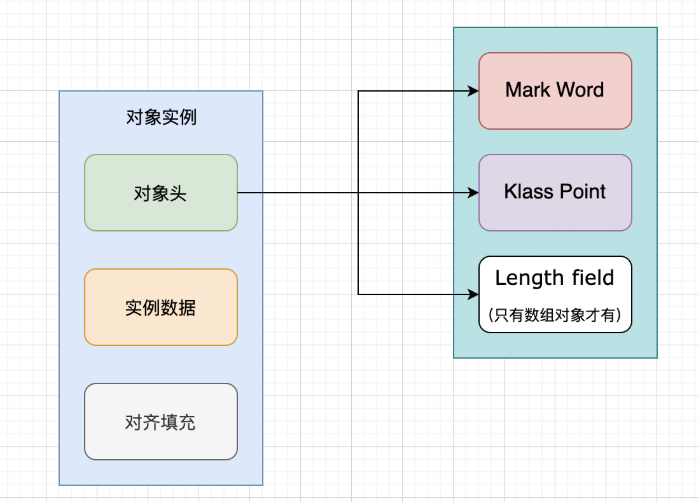



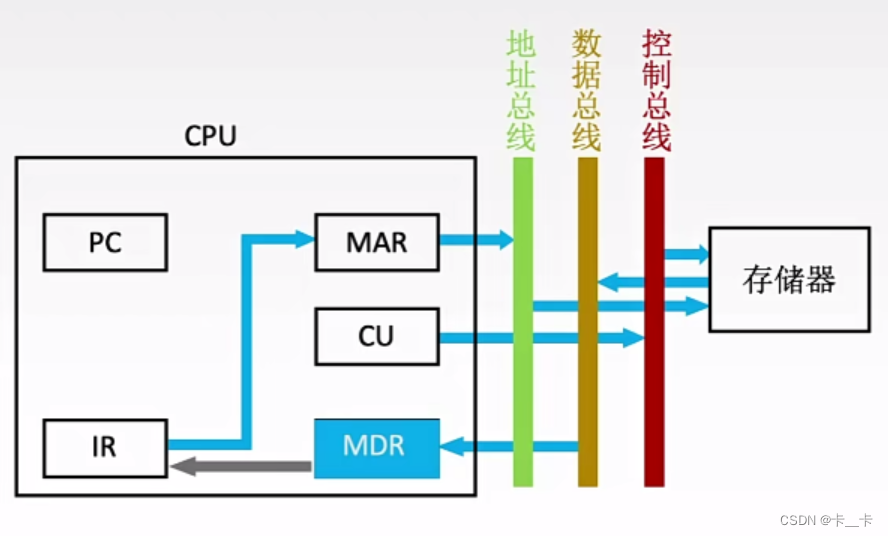


![[LeetCode周赛复盘] 第 329 场周赛20230122](https://img-blog.csdnimg.cn/b66cc45759404ae0976081c19c9c3e77.png)
